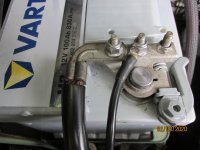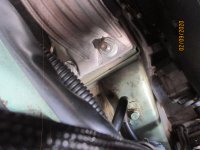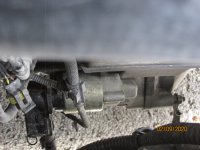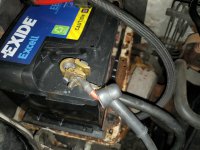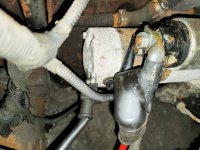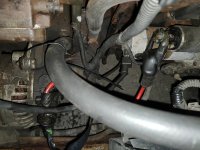EDIT: Amp test is showing 0.6 not being connected to Alt, jumps to 0.72 when i connect the Alt. (disconnect Neg lead from battery. VOM set to 10A terminal 200ma setting. One lead from Vom to battery Neg other to Neg lead.)
Hi folks I bought a bit of a monster here. Had it 3 weeks and it's had a problem every day since.
Most recently I left the rear doors open for a few hours and drained the battery. It was turning but not firing. I have another thread relating to this but it was a fuel leak that is now sorted.
Anyway, I only had a 50ah charger, so put the battery on for a couple hours then it fired up again. Took it for a run and parked it. Went to start the next day and it turned slowly but wouldn't fire.
I bought a Multimeter and checked the battery. It was showing around 12v, so i took it off and charged it over night. Bearing in mind my battery is 70ah, my little trusty 50ah charged it fully. I put my VOM on it and it was showing 13.2v. I put it back on the van and boom. Started Fast and Furious. I thought I'd sorted it.
Next morning I went out and before anything I checked the battery on the van. 12.1v. disappointed I turned the key. It started right away but I knew the drop in voltage wasn't a good sign. The van had previously been stood so I figued the battery was simply knackered as it wasn't holding a charge, so i went straight out and bought a new one.
Here's where it gets comlicated;for me anyway.
The old battery has been in the garden holding afull charge of 12.7v for 3 days!
The new battery keep dropping to 12.4 over night.
Here's what I know now.
VOM showing 13-14v while running telling me it's charging. Turn it off and the battery is showing 13+ volts, but then it visually drops in V's as the seconds pass.
If I remove the negative lead, the V's return to normal or at least stop dropping. Connect the Negative and it starts dropping again. (OK so this is a Positive Parasitic Draw)
Removed the aftermarket stereo, but no change. it still drops.
I don't know how this van should be wired, but there is a negative lead from teh battery to the starter. I'm assuming it's a ground? Held to the bottom of the starter by a small nut.
The positive lead comes from the battery to the starter first then on to the Alternator. Assuming this is normal? I have checked using my VOM that the Diodes are ok; i think. I set my VOM to Diode, touched the Positive on the Alt and touched the casing with the negative terminal. No reading. swapped the red and black and reading around 550.
This is a simply van. No remote locking, interior lights off, doors shut.
If i connect only the starter, the VOM shows no drain. Only when I connect the Alt does the V's drop. All of these testes on Start and Alt were with engine off.
I'm a bit stuck.~
Only other thing i could add is that the single wire from the alternator that I've assumed it for the Bash light for the battery, was recently snapped. I've reattached it.
Hi folks I bought a bit of a monster here. Had it 3 weeks and it's had a problem every day since.
Most recently I left the rear doors open for a few hours and drained the battery. It was turning but not firing. I have another thread relating to this but it was a fuel leak that is now sorted.
Anyway, I only had a 50ah charger, so put the battery on for a couple hours then it fired up again. Took it for a run and parked it. Went to start the next day and it turned slowly but wouldn't fire.
I bought a Multimeter and checked the battery. It was showing around 12v, so i took it off and charged it over night. Bearing in mind my battery is 70ah, my little trusty 50ah charged it fully. I put my VOM on it and it was showing 13.2v. I put it back on the van and boom. Started Fast and Furious. I thought I'd sorted it.
Next morning I went out and before anything I checked the battery on the van. 12.1v. disappointed I turned the key. It started right away but I knew the drop in voltage wasn't a good sign. The van had previously been stood so I figued the battery was simply knackered as it wasn't holding a charge, so i went straight out and bought a new one.
Here's where it gets comlicated;for me anyway.
The old battery has been in the garden holding afull charge of 12.7v for 3 days!
The new battery keep dropping to 12.4 over night.
Here's what I know now.
VOM showing 13-14v while running telling me it's charging. Turn it off and the battery is showing 13+ volts, but then it visually drops in V's as the seconds pass.
If I remove the negative lead, the V's return to normal or at least stop dropping. Connect the Negative and it starts dropping again. (OK so this is a Positive Parasitic Draw)
Removed the aftermarket stereo, but no change. it still drops.
I don't know how this van should be wired, but there is a negative lead from teh battery to the starter. I'm assuming it's a ground? Held to the bottom of the starter by a small nut.
The positive lead comes from the battery to the starter first then on to the Alternator. Assuming this is normal? I have checked using my VOM that the Diodes are ok; i think. I set my VOM to Diode, touched the Positive on the Alt and touched the casing with the negative terminal. No reading. swapped the red and black and reading around 550.
This is a simply van. No remote locking, interior lights off, doors shut.
If i connect only the starter, the VOM shows no drain. Only when I connect the Alt does the V's drop. All of these testes on Start and Alt were with engine off.
I'm a bit stuck.~
Only other thing i could add is that the single wire from the alternator that I've assumed it for the Bash light for the battery, was recently snapped. I've reattached it.
Last edited:


